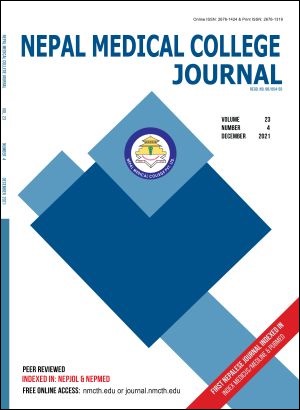Outcome of Locally Assembled Continous Positive Airway Pressure Device in Neonates with Respiratory Distress in Low Resource Setting
DOI:
https://doi.org/10.3126/nmcj.v23i4.42210Keywords:
Locally assembled CPAP, respiratory distress, newbornAbstract
Respiratory distress is the most frequent cause of neonatal admission in neonatal intensive care unit (NICU). Continuous Positive Airway Pressure (CPAP) is an effective mode of treatment in newborn with respiratory distress. CPAP is the application of positive pressure to the airways of spontaneously breathing patient throughout the respiratory cycle. Low cost CPAP can be locally assembled and used in neonates with respiratory distress to reduce the mortality. This is a cross sectional descriptive study conducted in NICU of Nepal Medical College Teaching Hospital from the period of June 2021 to September 2021 to assess the outcome of locally assembled CPAP. A total of 96 newborns with respiratory distress were included in the study. Severity of respiratory distress was assessed by Downes score. Downes score before and after CPAP were recorded. Newborn with Downes score of ≥4 was started with locally assembled CPAP. Outcome was taken as improvement when the respiratory distress was decreased with Downes score<4. And it was taken as a failure when baby required mechanical ventilation. Mean Downes score before starting CPAP was 4.81 and after CPAP was 0.51. Mean CPAP pressure was 4.27cm of water. Outcome of study showed, 80 (83.3%) babies were improved, 7 (7.3%) had failed CPAP who required mechanical ventilation and 1 (1%) baby expired. In conclusion, locally assembled CPAP shown to be equally effective as standard CPAP device and can be used as an effective alternative to mechanical ventilator in developing country with limited resource setting.
Downloads
Downloads
Published
How to Cite
Issue
Section
License
Copyright (c) 2021 Nepal Medical College Journal

This work is licensed under a Creative Commons Attribution 4.0 International License.
This license enables reusers to distribute, remix, adapt, and build upon the material in any medium or format, so long as attribution is given to the creator. The license allows for commercial use.




